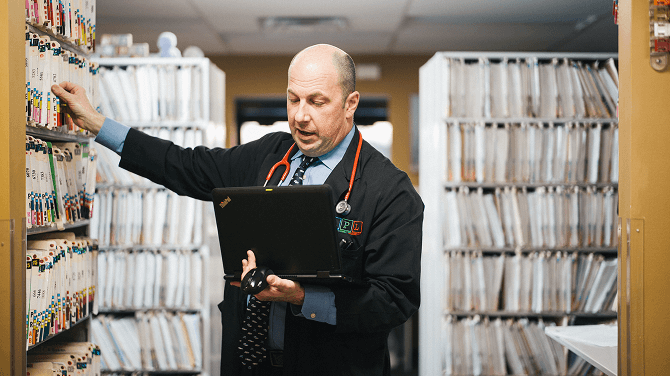The powerful payer partnerships driving real change in the moment of care
Behind the scenes of every patient encounter is essential information: not only the provider’s knowledge of medicine and of the patient’s history, but also the payer’s member health data which adds valuable insight to the overall picture of care. Fostering effective partnerships between payers and providers is essential for developing this picture – and for aligning care goals, streamlining processes, and tackling care gaps more efficiently. Ultimately, it’s about creating healthcare experiences that truly benefit members, an end goal that technology is working hard to help achieve.
As an EHR vendor, athenahealth has played a key role as facilitator of these crucial payer-provider collaborations. By staying aligned with Da Vinci standards, athenahealth is able to implement data exchange and connect the healthcare ecosystem of payers, providers, patients, and partners. Thanks to the solid partnerships athenahealth has built with some of the largest national payers, the healthcare ecosystem is growing more connected by the day.
Recently, Greg LeGrow, Executive Director of Payer Product Strategy at athenahealth, took the stage at the 2025 AHIP Conference to discuss athenahealth’s innovative payer partnerships and how they’re working to surface actionable insights within the EHR. Read on to learn more about these forward-thinking health insurance technology and data collaborations and how they’re paving the way for opportunities to enhance member care.
The right data, delivered for better patient outcomes
Since 2019, athenahealth has worked with major national payers on solutions and products to bridge long-standing gaps between payers and providers, not only to improve the flow of information, but to make that information truly usable at the point of care. Their shared goal has been simple but ambitious: reducing administrative burden, supporting value-based care, and improving outcomes through smarter connectivity.
The collaboration began with the creation of Health Plan Data Exchange (HPDE), which streamlines the way payers access their members’ clinical encounter data and replaces the time-consuming manual “chart chase.” Since then, the partnership has expanded to develop services that surface valuable data in the clinical encounter to enable better care outcomes, including:
- Care Gaps
- Diagnosis Gaps
- Provider Network Directory (to optimize referrals)
- ADT Notifications (product in development)
- Medical Electronic Prior Authorization
As LeGrow explains, “We’re focusing on interoperability and working with like-minded organizations where we can actually implement solutions to help reduce administrative burden on both payers and providers and improve historically challenging industry processes.”
This work reflects a model of continuous improvement. The teams routinely review data, provider feedback, and performance metrics to refine existing services and identify new opportunities. Their efforts have earned national recognition, including multiple KLAS Points of Light awards highlighting meaningful advances in payer-provider collaboration.
What distinguishes this partnership is a strong alignment — on objectives, measurable outcomes, and the belief that solving healthcare’s most persistent challenges requires more than technology. It requires trusted, sustained collaboration.
By investing in innovation, we can improve the way that medical prior authorization processes are done. Being able to expand this across a wider market is exactly what we’re hoping to do.
Greg LeGrow, Executive Director of Payer Product Strategy at athenahealth
Reducing administrative burden through automation
One of the most pressing challenges in healthcare is the administrative burden placed on providers to obtain medical prior authorizations. To reduce the time and effort involved, athenahealth worked with Humana to develop an automated end-to-end prior authorization solution. This innovative system has dramatically reduced the time required for authorization determinations, with the average turnaround now at just 26 hours1, compared to industry averages that can extend into days or weeks.
Furthermore, 70% of prior authorizations are now auto-approved2, significantly streamlining workflows and allowing healthcare providers to focus on patient care instead of waiting on hold.
Surfacing information in the clinical workflow
athenahealth’s partnerships with payers have also made significant advancements by surfacing critical information at the right time and place to support patient care. Starting 14 days prior to a patient’s visit, athenaOne automatically requests information from payers regarding any open care or diagnosis gaps, and periodically checks again up until the day of the appointment.
This proactive approach allows healthcare providers to access relevant information directly within their clinical workflows, enabling them to address gaps in care during patient visits and return evidence to the payer when gaps are closed. With more than 25 million care gaps and diagnosis gaps surfaced across the athenahealth® network in 20243, the Care Gaps and Diagnosis Gaps solutions have had a clear impact on provider and payer performance and member outcomes.
Enhancing interoperability through Da Vinci FHIR standards
A cornerstone of the partnership's success is the adoption of Da Vinci FHIR standards, which facilitate improved data exchange between payers and providers. This enhanced interoperability is crucial for creating seamless workflows that support efficient healthcare delivery. By leveraging these standards, athenahealth and its payer partners have enabled better communication and collaboration, allowing providers to access critical patient information in real time, directly within the native workflow. This integration not only streamlines processes but also fosters a more connected healthcare ecosystem, ultimately leading to improved operational efficiency.
The road to payer-provider collaboration is paved with opportunity
During the presentation, LeGrow mentioned several future initiatives, including improvements to medical prior authorization workflows, ADT notifications to support the transition of care, and the optimization of referral management. He expressed the teams’ shared commitment to continuous improvement and collaboration.
As LeGrow says, “By investing in innovation, we can improve the way that medical prior authorization processes are done. Being able to expand this across a wider market is exactly what we’re hoping to do and prove through the work we’ve done together that it is worth the investment.” It’s about leveraging new technologies in the health insurance industry to forge connections and drive efficiency. This partnership helps the two businesses move faster, create more, iterate, improve, and ultimately cure complexity for the benefit of payers, providers, and other stakeholders across the healthcare ecosystem.
Interested in fostering better connections across the healthcare ecosystem and improving patient outcomes? Explore the athenaPayer suite of solutions.
More payer solutions resources
Continue exploring
Individual customer results may vary. These customer experiences do not guarantee results or performance that any individual customer may experience or should expect.
1. Data source: Assuming 15 minutes per authorization verification; athenahealth: Humana UC1 Data Extract, 10/1/23 - 12/31/23
2. Humana: Instant Approval &Pended Auth Rate, 1/1/23 - 12/20/23
3. athenaOne data for 12 months ending December 2024













